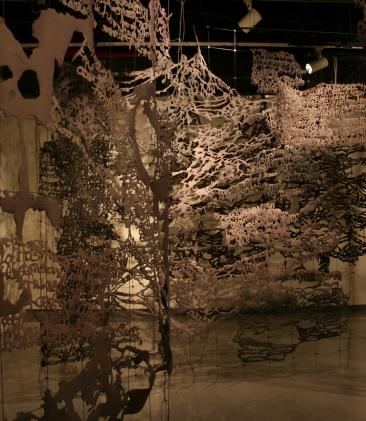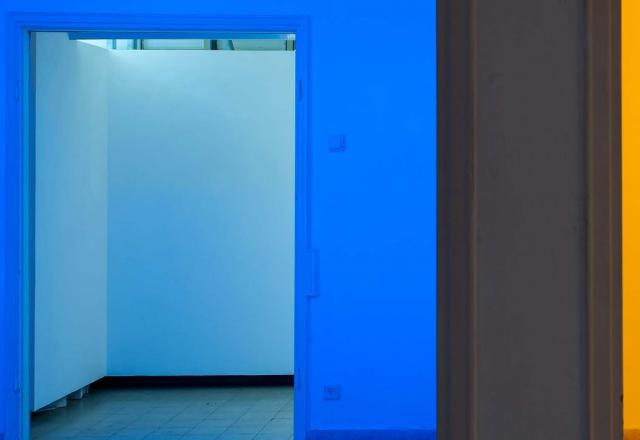The Faculty of Mathematics and Sciences is running an Artist in Residence project aimed at fostering interdisciplinary research and encouraging collaborations that will expand research horizons and lead to new breakthroughs.
The project, akin to those at many leading universities around the world, began operating at the Hebrew University in 2013 and has since hosted three artists, each for a year-long residency.
Prof. Idan Segev writes, "What a scientist and an artist share is the urge to understand the world around us, each with the cognitive and professional tools they have acquired. Often the artist precedes the scientist with his insights (visual or perspective), and sometimes the scientist allows the artist to expand their field of work (such as understanding the structure of the human body as in Leonardo Da Vinci's paintings). A fruitful friction between these 'two cultures' is likely to lead to a significant breakthrough, both in science and in art.
Nowadays, in the dichotomous world we have created, the artist and scientist tend to withdraw inwards, rarely allowing real friction, constructive and extended, between their two disciplines. The aim of the Artist in Residence program is to establish a stable and lasting framework at the Hebrew University that will bring together a variety of creative artists (from visual arts, music, movement and writing) and scientists from different fields. It is likely that such an encounter would encourage the scientist to think “outside the box” and for the artist to be introduced to new concepts and materials (think nanotechnology), diverse research and far-reaching ideas that will allow them to expand their artistic activity.
The Artist in Residence studio is located on the Edmond J. Safra Campus, Sherman Building, 5th Floor, Room 503.
As part of the Artist in Residence project three artists have so far been hosted at the University:
Penny Hes Yassour | 2015-2016
Penny Hes Yassour, a multimedia artist, exhibits in Israel and abroad. Yassour participated in the 10th Documenta in Kassel, and exhibited at the Friedriezianum Museum, and in the Asian Art Biennial in Taiwan. In 2009 she created an art installation for a performance of Shakespeare’s The Tempest at the Freiburg Theater, and in 2014 she was invited to residence at Stanford University. Yassour received numerous prizes, including the Arnold Bode Prize, the Israel National Lottery Council for the Arts Award for Excellence in Art, and the Israel Minister of Culture and Sport’s Award. Yassour is a lecturer at the Bezalel Academy of Art and Design, and at the Shenkar College of Engineering, Design and Art.
Nivi Alroy | 2015-2016
Nivi Alroy (1978), a multidisciplinary artist, incorporates in her work drawing, sculpture, architectural constructions, video and animation. Alroy has participated in a variety of Residency Programs. She appeared on the “Hot Picks” lists of the New York Magazine and Smack Mellon, and received the Ahuvi Most Promising artist award and the Frida E. Issiccoff alumni award. Her art is exhibited in Israel and internationally.
Ahead of her post as the Hebrew University’s Artist in Residence, she wrote:
“I’m drawn to the point where order is lost, and things reconstruct and are reborn as something other. I attempt to bring together ecosystems, urban systems, disintegration and rebirth of communities, turning science into whimsy.
In recent years, I have been inspired by de-extinction: a controversial practice, which involves genetic engineering and cloning with the aim of recreating extinct species. These heroic/hopeless human attempts to capture and defy the passage of time by creating lab-induced nature provoke me to comment on ends and beginnings; life and death.
I link the basic forms of life to human relationships and aim to capture a snapshot of movement, as if frozen in time. My sculptures often refer to controlled chaos; the organic and inorganic colliding and fusing into one another, revealing a game between careful planning and happy accidents. I built a sculpture on a raft, leaving it in on the Alexander river for four months, and then placing it in a closed room with the accumulated mildew, spider webs and moss.
I'm obsessed with research, which manifests itself in highly detailed work, involving data and visual narrative. A project begins with a historical character, a certain place or scientific data in mind that slowly finds the right medium of expression after dozens of drawings. My challenge is to translate drawing, my most immediate language, into sculpture, installation and time-based media. Using this process, I understand the rules and grammar of the worlds I create.
I describe the form and invisible details, such as the life hidden in it or underneath it. I incorporate in my work traditional crafts to found objects, organic materials and animation. The forms in my sculptures often seem to flow, erupt or bubble out of its vessels, breaching the borders but by some mysterious force, freeze before the consequences are revealed. I, often, bury personal objects in layers of matter and then slowly dig out, sand down and reveal the hidden object, creating an excavation of the present.”
Adi Nes | 2014-2015
Adi Nes (1966), an Israeli photographer who works in the genre of staged photography, has won numerous awards, including the Nathan Gottesdiener Foundation for Israeli Art Prize (2000), and the Culture and Sport Minister's Prize for Artists in the Visual Arts (2013).
His photographs appear in leading museums and private collections in Israel and around the world. Nes is a postmodernist artist. His works combine a wealth of quotations from art history, philosophy and subversive dialogue with the Israeli culture.
In his proposal as Artist in Residence, he discussed the significant changes the world of photography is experiencing and his own search for a new visual language that can connect to new areas of knowledge.
The program he offered is characterized by an open approach to collaboration: the project will embark from a personal interest of the scientist and the artist, mutual acquaintance and from the ensuing relationship between the artist and the research group. His upcoming exhibition will be devoted to the fruits of his stay within the walls of The Hebrew University.
Boris Oicherman | 2013-2014
Boris Oicherman (1973) is a multidisciplinary artist working with site-specific projects, installation, sculpture, sound and media, looking at the architectural, environmental, cultural and historical aspects of a place. Oicherman has participated in a number of exhibitions and residences in Israel, the United States, Poland and South Korea, among other countries. He is the recipient of the Asia Pacific Fellowship of the National Museum of Contemporary Art in Seoul, South Korea (2012), the Artport Residency in Israel (2013-2014), and a number of the Israeli Lottery Fund production and research grants.
During his time as Artist in Residence at the Hebrew University, Oicherman became acquainted with the research of Prof. Israel Nelken and Prof. David Avnir. Together the three have established a sound installation about the perception of symmetry. With standing waves, where an array of standing sound waves of different frequencies creates a pattern of chords in space, a listener walking through the space experiences a continuous change in timbre. The idea emerged from discussing the concept of space becoming the musical instrument which is played by moving in it.















